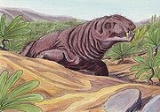
Deuterosaurus
Encyclopedia
Deuterosaurus is a genus
of the Therapsids, one of the "mammal-like” reptiles dominating land during the late Palaeozoic.
s, the skull possessed long, dagger-like canine teeth. The skull was rather short for an antosaur, with a broad cheek region, indicating a very strong bite. The eyes where partly slanted forward, giving it at least partial stereo vision. The pineal eye, though small, had a well formed opening right atop the brain case.
Deuterosaurus was a very large animal; the size of a modern grizzly bear
. T. H. Huxley mistakenly considered it to be a dinosaur
. With its long tail, it had an adult length of 5-6 meters (15-18 ft) and weighted around half a ton. Judging from related therapsids, the short but massive legs where held sprawling, much like a modern crocodile. When walking, the tail would have swung sideways, like in modern reptiles.
, which in the Permian was dominated by temperate lowlands. Deuterosaurus was among the largest animals of its day, and has variously been interpreted as a herbivore
or carnivore
. While the large canines may indicate the ability to kill prey, the short legs and massive body would have made it unsuited as a long distance runner, and better suited to eating plants. Then again, the possible stereoscopic vision again indicates an ambush style carnivore, and the rather blunt, cone-like post canine teeth can be interpreted bout ways. Possibly, Deuterosaurus was omnivorous, like a modern bear.
Deuterosaurus, like all its therapsid cousins, laid eggs. A remarkable thickening of the skull above the eyes indicates it may have engaged in head-butting, possibly in connection with mating or territorial disputes.
Genus
In biology, a genus is a low-level taxonomic rank used in the biological classification of living and fossil organisms, which is an example of definition by genus and differentia...
of the Therapsids, one of the "mammal-like” reptiles dominating land during the late Palaeozoic.
Anatomy
Skulls of Deuterosaurus are well-known from several finds. They were around 80 cm (2 ft 6 in) with a long snout and conical teeth. Like all anteosaurAnteosaur
Anteosaurs are a group of large, primitive carnivorous Dinocephalians , with huge canines and incisors and short limbs, that are known from the Middle Permian of South Africa, Russia, and China. The largest grew to very large size, with skulls 50 to 80 cm long, and were the largest predators...
s, the skull possessed long, dagger-like canine teeth. The skull was rather short for an antosaur, with a broad cheek region, indicating a very strong bite. The eyes where partly slanted forward, giving it at least partial stereo vision. The pineal eye, though small, had a well formed opening right atop the brain case.
Deuterosaurus was a very large animal; the size of a modern grizzly bear
Grizzly Bear
The grizzly bear , also known as the silvertip bear, the grizzly, or the North American brown bear, is a subspecies of brown bear that generally lives in the uplands of western North America...
. T. H. Huxley mistakenly considered it to be a dinosaur
Dinosaur
Dinosaurs are a diverse group of animals of the clade and superorder Dinosauria. They were the dominant terrestrial vertebrates for over 160 million years, from the late Triassic period until the end of the Cretaceous , when the Cretaceous–Paleogene extinction event led to the extinction of...
. With its long tail, it had an adult length of 5-6 meters (15-18 ft) and weighted around half a ton. Judging from related therapsids, the short but massive legs where held sprawling, much like a modern crocodile. When walking, the tail would have swung sideways, like in modern reptiles.
Biology
Deuterosaurus is found in what is now SiberiaSiberia
Siberia is an extensive region constituting almost all of Northern Asia. Comprising the central and eastern portion of the Russian Federation, it was part of the Soviet Union from its beginning, as its predecessor states, the Tsardom of Russia and the Russian Empire, conquered it during the 16th...
, which in the Permian was dominated by temperate lowlands. Deuterosaurus was among the largest animals of its day, and has variously been interpreted as a herbivore
Herbivore
Herbivores are organisms that are anatomically and physiologically adapted to eat plant-based foods. Herbivory is a form of consumption in which an organism principally eats autotrophs such as plants, algae and photosynthesizing bacteria. More generally, organisms that feed on autotrophs in...
or carnivore
Carnivore
A carnivore meaning 'meat eater' is an organism that derives its energy and nutrient requirements from a diet consisting mainly or exclusively of animal tissue, whether through predation or scavenging...
. While the large canines may indicate the ability to kill prey, the short legs and massive body would have made it unsuited as a long distance runner, and better suited to eating plants. Then again, the possible stereoscopic vision again indicates an ambush style carnivore, and the rather blunt, cone-like post canine teeth can be interpreted bout ways. Possibly, Deuterosaurus was omnivorous, like a modern bear.
Deuterosaurus, like all its therapsid cousins, laid eggs. A remarkable thickening of the skull above the eyes indicates it may have engaged in head-butting, possibly in connection with mating or territorial disputes.

